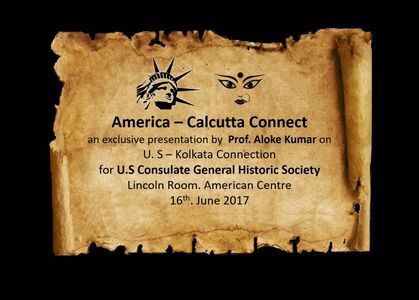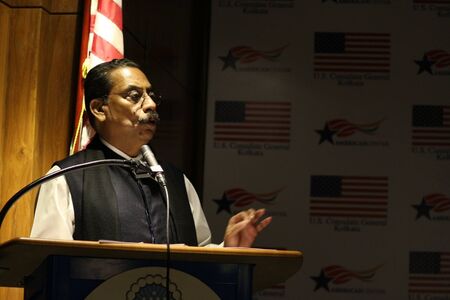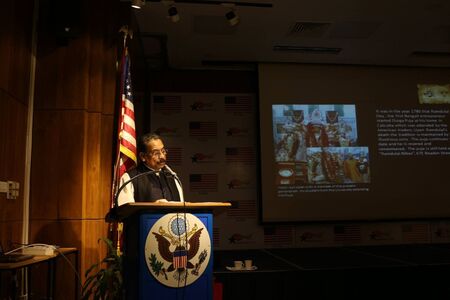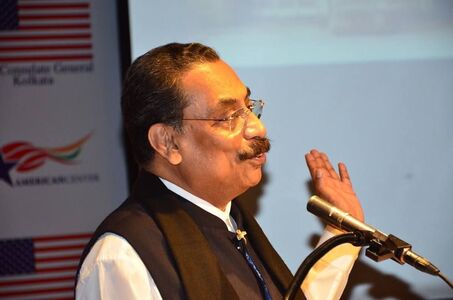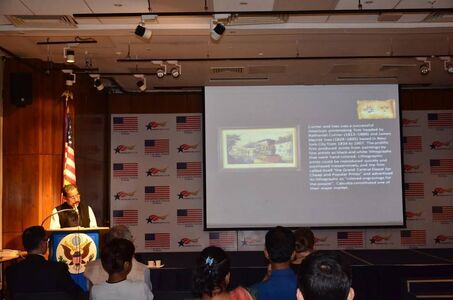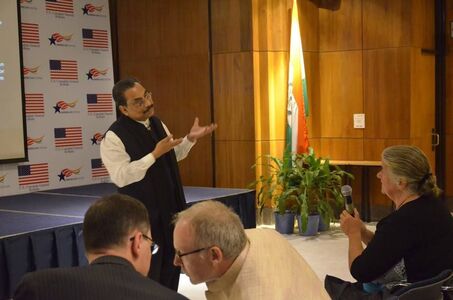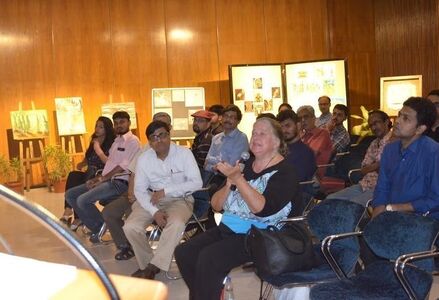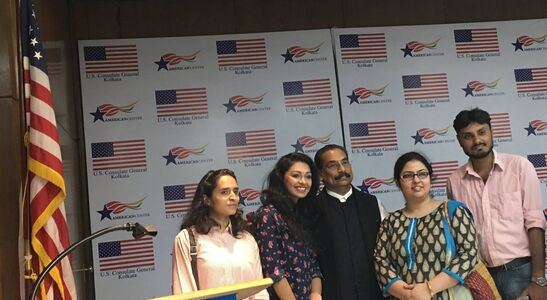for U.S Consulate General Historic Society
Lincoln Room. American Centre
16th. June 2017
America has a deep connect with Calcutta. While we speak and write the British, French, Dutch and even Portuguese connect we hardly ever mention the American connect as few of us are aware of. America and Calcutta has a connect in the sphere of History, Trade, Culture.
The history of the American Calcutta Connect began around 1778. American merchants had begun trading in India in 1778 when Lord Cornwallis extended the opportunity. It was a critical time for the newly independent America. Being cut off from the West Indies and deprived of their traditional market, they were on the look for a new opportunity for trading. The Napoleonic wars came their way to replace Europe’s East India trade. President George Washington, on November 19, 1792, nominated Benjamin Joy of Newbury Port as the first American Consul to Calcutta. He was never recognized as Consul by the British East India Company but was permitted to reside here as a Commercial Agent. Despite this rather inauspicious beginning, Benjamin Joy's arrival was the beginning of a long official American relationship with Calcutta --- and, indeed, with all of India.
In 1806 Calcutta was the most active Indian port for their commerce. They made use of the services of the Bengali businessmen known as ‘Banias’, or the Indian brokers. Among them Ramdulal Dey was the first and most famous Bania connected with the American trade. Ramdulal Dey, the millionaire Bengal merchant of late 18th and early 19th centuries, was the foremost name in the chronicle of Indo-American maritime trade. Trading in Calcutta was one of the very important mercantile experiences of America during her early phase of modern globalization. From 1790 American trade with British India grew fast. Mostly the merchant houses of Boston, Salem, Philadelphia, Providence, Marblehead and New York sent their ships regularly to buy Bengal goods. American merchants had begun trading in India in 1778 when Lord Cornwallis extended the opportunities to them, but transporting and trading in ice was a different matter altogether. It was in 1833 when ice first reached Calcutta.
In the early phase of globalization, nineteenth-century cosmopolitan thinkers in America and India sought to articulate a universally inclusive cosmology, recognizing the common core of all religions. Rammohan Roy, for example, seeking spiritual renewal for a new age of enlightenment, turned to the fundamental universalism embedded in ancient Sanskrit scriptures. He also looked for inspiration in the teachings of other religions. In dialogue with American Christian Unitarians, he found especially congenial ideas, and the Unitarians, in turn, published Roy’s essays in prominent American periodicals.
The second as we all know was Swami Vivekananda who attended the Parliament of the World's Religions in1893, which was an attempt to create a global dialogue of faiths.The rest as we say is history, as Swami addressed the gathering as “Sisters and Brothers of America, it fills my heart with joy unspeakable to rise in response to the warm and cordial welcome which you have given us”. Swamiji became famous overnight and was a huge attraction and went on to win American hearts.
Rabindranath Tagore’s first sustained experience of America was not New York or San Francisco, but the farming university town of Urbana, Illinois. He went there in 1912, to visit his son Rathindranath, studying at the University of Illinois. Father Rabindranath had wanted his son not to study literature or the arts at a place like Oxford or Cambridge but rather agricultural science in the service of what Tagore hoped would turn into a program for village development.
World War II brought new complexities, boosting freedom struggles across the globe and stationing American troops in India. Franklin Delano Roosevelt became the first American president to openly support Indian independence, though he did so cautiously in deference to the critical alliance between the United States and Great Britain. In 1942, the American soldiers arrived in Calcutta. Wartime Calcutta was a huge military transit camp as the Allies engaged the Japanese in Burma.
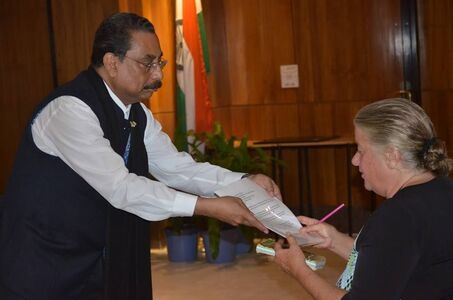
At a time when Calcutta took pride in the British Prints of Thomas & William Daniell my father, the first antiquarian of Calcutta, imported American prints of Currier & Ives. Whilst the prints of British Artists were in limited edition and thus expensive, the American prints were mass produced and cheap. The Bengali middle class and the merchant class took to these prints and made it their own. Currier and Ives was a successful American printmaking firm headed by Nathaniel Currier (1813–1888) and James Merritt Ives (1824–1895) based in New York City from 1834 to 1907.
The Discovery of India was written by India's first Prime Minister Jawaharlal Nehru during his imprisonment in 1942-1946 at the Ahmednagar Fort prison. However after coming out of jail he tried to publish the book but failed due to political pressure from the British. In his desperation he handed over the manuscript to D K Gupta of Signet Press in Calcutta with the hope that Calcutta being the epicenter of such publications, the book will be released. It was left to Gupta to send the manuscript to an obscure publisher by the name of John Day & Co. for the book to be published from New York in 1946.
Uday Shankar, brother of sitar master Ravi Shankar, initiated modern dance in India by blending local traditions and Western styles. Uday was the first Indian dancer to perform in prominent American venues, and leading American impresario Sol Hurok managed his highly acclaimed U.S. tour in the 1930s. Modern dance pioneer Ruth St. Denis first saw Indian performers of Uday Shankar at Coney Island in New York. She was instantly enthralled. Experimenting with poses from Uday Shankar’s Dance Ballet, St. Denis started her ‘Hindu’-style performances in America and eventually in India.
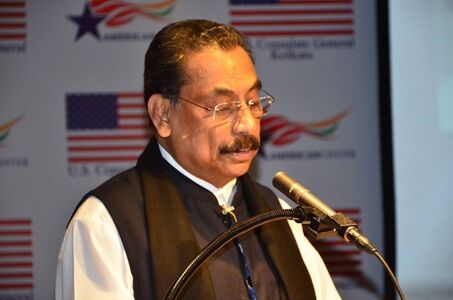

Satyajit Ray himself has confessed that he was influenced by John Ford and Frank Capra to name a few. Later in his Oscar Speech he commented: “I have learned everything I've learned about the craft of cinema from the making of American films. I've been watching American films very carefully over the years and I loved them for what they entertain, and then later loved them for what they taught. So, I express my gratitude to the American cinema, to the motion picture association who have given me this award and who have made me feel so proud. Thank you very, very much.” March 30, 1992.
Calcutta also gave birth to many American authors. One was Richard Beard, an US Army Lieutenant. He wrote the book: From Calcutta with Love: The World War II Letters of Richard and Reva Beard. Richard Beard, an Army psychologist assigned to the 142nd General Hospital in Calcutta, dealt daily with emotional trauma.
Alexander Graham Bell was a Scottish-born scientist, inventor, engineer and innovator who patented the first practical telephone. Bell was awarded the first U.S. patent for the telephone in 1876 which saw the mass production of telephone instruments. The American Bell telephone Co exported the instrument to Calcutta. The first advertisement appeared in The Statesman Calcutta.


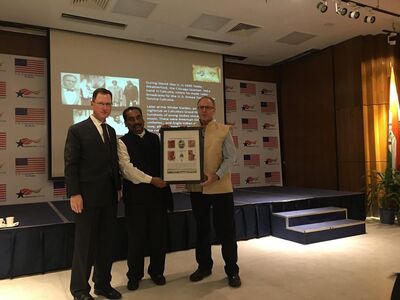
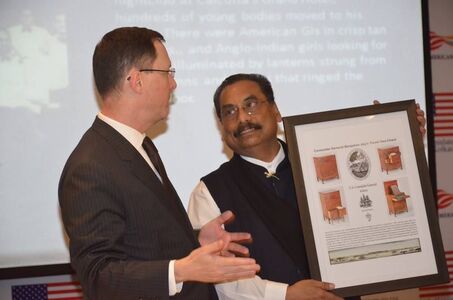
Coca-Cola came to Calcutta in the year 1956. Coca-Cola is a carbonated soft drink produced by The Coca-Cola Company. Originally intended as a patent medicine, it was invented in the late 19th century by John Pemberton and was bought out by businessman Griggs Candler, whose marketing tactics led Coca-Cola to its dominance of the world soft-drink market throughout the 20th century. It is interesting to note that the bottling plant was started in Calcutta in Karnania Estate on Lower Circular road which had originally housed the apartments for the Gis.
Pianos had to be imported since they were not manufactured in India. Even when imported they were unaffordable even for the rich, with stiff import duties and many other barriers. So the American organ - a free-reed instrument which could double up was imported to Calcutta in early 1900s. In the initial years Dwarkin and Calcutta Piano Shop sold the American Organ.
The Metro cinema hall was built by Metro-Goldwyn-Mayer, an American Production Company, based in Beverly Hills, United States in 1934 to promote their films in Calcutta, which was among the most important cities. Famous as an elite city, Calcutta had a large market for Hollywood films. It was inaugurated in 1935. The first film shown in this cinema was Way Out West. The Metro was the most modern of the cinemas in Calcutta.
From cinema to magic, in virtually all areas of entertainment, artists and audiences in the United States and India found inspiration and enjoyment in each other’s productions. In the early twentieth century, America’s leading magician, Howard Thurston, visited India and came to Calcutta to see its famed practitioners of illusion and from this experience crafted his own version of the Indian ‘rope-trick.’ He first performed at Empire Theatre in Calcutta.
Links :
View the Presentation Slides on Slideshare
Read the Full Text of the Presentation

